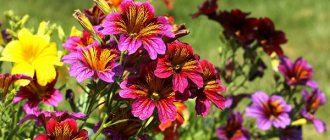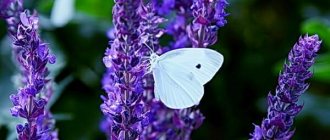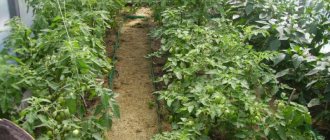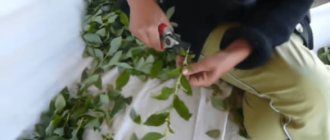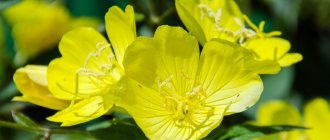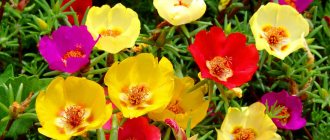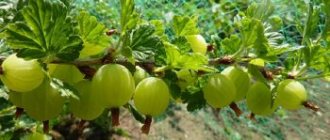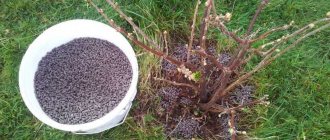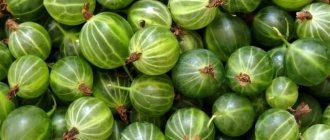Lobelia is a surprisingly delicate flower that looks just like the picture in real life. The plant is suitable for growing in the front garden, flower beds, window sills and balconies. Creates an amazing decor from abundantly flowering plants throughout the growing season.
The proximity to other flower crops allows you to make the natural carpet more lush and unique. It is worth talking separately and thoroughly about how to plant lobelia seedlings and care for seedlings. After all, this will help you avoid mistakes and create masterpieces of art.
Botanical description and popular varieties of culture
Lobelia is a perennial flowering plant. There are more than 300 species forms, but only 2-3 dozen species are offered for garden cultivation.
Campanula family. The place of growth, the birthplace of the flower is the African continent (southern side). Can also be found in subtropical zones.
In nature, lobelia prefers rocky soil and loves high humidity. At home, the flower changes its preferences and becomes an annual crop.
External data:
- shoots: thin and flexible:
- highly branched;
- abundant green mass:
- the bush has the shape of a ball or column;
- height: depends on the shape. From 15 to 40 cm.
Since there are many types of lobelia, there are also creeping ground cover forms. In such species, the stem is longer: 10-40 cm. If we summarize the biological indicators, lobelia is a plant with spiral-shaped small leaves. The foliage is also characterized as sessile lanceolate. Serrated edges.
The flowers are solitary axillary, diameter – 2-3 cm. The color of the flower is varied. The most popular colors: all shades of blue and light blue, pastel colors. There are types of white, pink and crimson colors of varying intensities.
Flowering is long lasting. Start: June. Completion: September-October.
Need to know! Lobelia can be grown in literally all climate zones. You just need to know exactly which varieties are resistant to frost and sudden temperature changes. These include: Lobelia Strong, Ricardi ampelous, Erinus, Gerardi, Fiery.
Dwarf
The lobelia species is highly branched. Height: 10-20 cm. Inflorescences are small, no more than 1-2 cm in diameter. Color: all shades of blue, purple, pink. There are white hybrid forms.
The species is represented by two types: ampelous and regular. It takes root and develops well both in the shade and in the sun. The main condition: moist soil.
Compact
Lobelia compacta is popular for its unique qualities. Suitable for growing in the garden, on the balcony, in flower pots. Will become a decoration for flower beds and flower beds. It has long, abundant flowering. There are several types: ampel and cascade.
The group included about 10 varieties. Mainly blue and its shades. Height ranges from 8 to 15 cm.
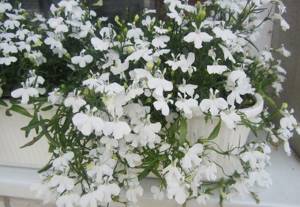
Erect
This type of lobelia is distinguished by its height. Quite long flowers: up to 75 cm.
They love high humidity, so in the wild they grow near ponds and wetlands. Mostly red. There are two varieties of erect lobelia: Fulgens and Cardinal.
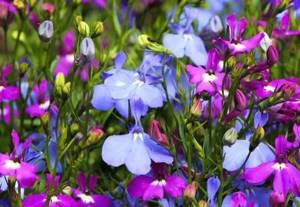
Ampelous or climbing
Differences: very long, drooping shoots. Recommended for pots, home (indoor) flower beds. There are three varieties that are the strongest and most resistant to temperature changes:
- white color - Curacao Basket;
- blue flowers with a white eye - Curacao Blue;
- heavenly color with a white eye - Technohat Trailing Light Blue.
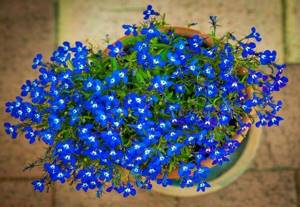
Garden forms and types of lobelia
- Compact. Rounded bushes up to 20 cm in height.
- Upright. Columnar bushes about 30 cm high.
- Climbing. Cascading shoots from 30 to 50 cm long.
Gardeners grow several types of plants, which differ in stem height and bush volume:
- Bush lobelia. The stems of spreading and compact bushes of various varieties reach 30 cm. They are used to decorate flower beds and ridges.
- Lobelia ampelous. Growing stems over 30 cm from seeds is recommended for planting in flower pots, garden baskets, and for decorating balconies and terraces.
Optimal timing
Lobelias develop rather slowly. It takes 2-3 months for the seedlings to be transplanted to a permanent location. This nuance is the main indicator for sowing seeds. Approximate dates: February – April.
In the southern regions, the procedure can be carried out at the end of January. Then the bushes will bloom earlier. It will be possible to replant only with stable heat. If necessary, lobelias provide illumination with non-incandescent lamps.
Depending on the region
It is often recommended to germinate lobelias together with petunias, since the care is similar and the time until the first leaves/flowers appear. Plants behave well as neighbors and are combined for decoration.
Depending on the region, seeds are sown:
- the last week of March - the first ten days of April is suitable for Siberia and cold areas;
- in the Urals, planting times are reduced from Siberian ones by 1-2 weeks. Planting is approximately planned for mid-March;
- Throughout February, lobelia is practiced in the Moscow region and the Black Earth Region.
Before sowing into the ground, the seeds must be processed and dried. Therefore, it is worth adding another 3-5 days to the intended sowing, so as not to be late with planting the seedlings in a permanent place.

We select the date according to the lunar calendar
It is important to carry out activities for working with seeds in accordance with the lunar calendar. Every year, the dates of favorable and unlucky days change by month. It is not always possible to calculate them accurately.
The main condition for calculation:
- avoid the full moon (from 14 to 16 lunar days);
- try to land on the waxing moon;
- If there are days of the waning moon, it is worth checking the gardener’s calendar to see if the chosen day is correct. Such tips are available for free sale.
The soaking procedure is carried out taking into account favorable lunar days. Since the seeds are small, this step is often skipped.
Important! Don't try to skip the step of germinating seeds in separate containers. Lobelia seed material is excessively fragile. Even at home, during the first cotyledons, seedlings die. You need to be prepared for this.
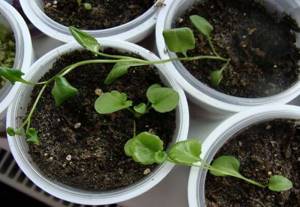
Germinating lobelia seeds at home
To successfully obtain seedlings, it is not enough to treat the seeds. Moreover, this stage is often skipped due to the size of the planting material. It is recommended to use the tricks of specialists with whom they are willing to share. Lobelias need to provide:
- carry out the disinfection procedure 10-14 days before direct sowing. It is not so much the seeds that are subjected to processing as the soil mixture and containers for planting;
- enough light and warmth;
- special soil;
- timely implementation of procedures (watering, picking, loosening, etc.).
Soil preparation
A young plant, like seeds, will feel better and more confident if I purchase a special soil mixture for seedlings. Store-bought soil consists of high-quality raw materials, containing only the necessary ingredients.
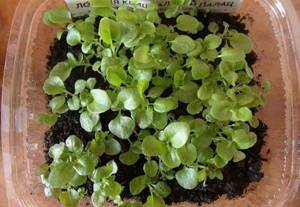
A positive aspect of buying soil in a store is that there is no steaming stage or additional processing for disinfection.
Soil requirements for lobelia: light, crumbly. The land from the site will not be suitable. It is better to opt for peat.
To improve the friability of the soil mixture, it is recommended to add sand to the substrate.
Selection of capacity
Containers in the form of cups or seedling boxes are not suitable for lobelias. Heavy containers are also not for them. Select a container with drainage holes along the walls and bottom. The more air there is, the faster the flowers will grow.
They will also protect the seedling from mold. After all, lobelia needs to be watered frequently to ensure high humidity.
Necessary conditions for growth
With the appearance of small green shoots, the lobelia is transferred to a bright place. At the same time, the temperature regime, frequency of watering, and duration of daylight are observed. Use artificial lighting.
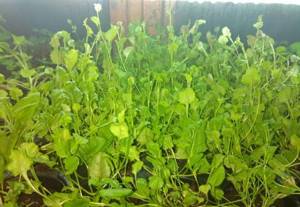
Lighting
Throughout the growth of seedlings, right up to transplantation to a permanent place, lobelia needs a lot of light. Since sowing occurs from February to April, you will need to purchase a non-incandescent lamp.
Otherwise, the sprouts will get burned and die. Duration of lighting maintenance: at least 12 hours.
Humidity
Not all plant varieties like a lot of water and high humidity. It is necessary to clarify the variety and watering requirements. In order not to destroy the sprout, water it by drip, using a syringe. You can also add water to the pan as needed.
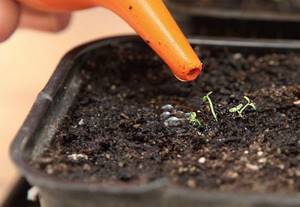
Temperature
The air temperature in the room where lobelias grow should not rise/fall below 18 degrees. Only after transplantation will the plant calmly tolerate temperature changes. It is necessary to carry out hardening and ventilation.
Top dressing
There is no need to feed the flower at the germination stage. All the necessary elements are already in the soil mixture.
Picking
A jewelry event that requires special attention. For the process of transferring the seedling you will need tweezers. As a last resort, a toothpick. The root system is not yet strong. Therefore, the seedling is transferred to separate containers along with the soil.
Containers for lobelia must meet the above requirements: the presence of drainage holes on the walls and bottom.
The picking procedure can be carried out only after 28-30 days after the sprouts appear.
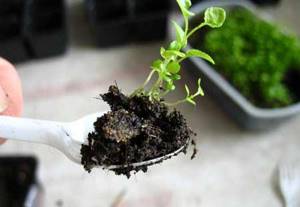
Pinching
The pinching procedure is necessary to create a neat, lush bush. When the sprout reaches 4 cm, the upper part should be trimmed with scissors treated with a disinfectant. You can also pinch it off with your fingers. Before using this antiseptic, wet your fingers and let them dry.
Hardening
Hardening of seedlings begins on the second day after planting. Looks like ventilation, removing condensation from the covering material. After the sprouts appear, the duration of these procedures increases gradually.
Removing the cover is a signal for real hardening. Pots of lobelia are brought out onto the loggia only 2-3 weeks after all the sprouts have appeared. Closer to transplantation, the hardening time should be 1-2 hours in the morning and the same in the evening.
How to care for lobelia seedlings
Periodically open the lid of the planter or the film for 10-15 minutes to ventilate the crops. Accumulated condensation can lead to the appearance of mold or moss on the surface of the ground, so droplets on the film or lid should be wiped off.
After the first leaves grow, the film is removed. But they do this gradually, simply increasing the ventilation time.
Important!
After you remove the cover or film from the seedlings, the young plants will find themselves without greenhouse conditions. And you will have to water them often. As soon as the soil surface dries out, water immediately! Otherwise, the small root will dry out and the lobelia seedlings will die.
During further cultivation, it is very important to control the humidity of the surrounding air. Drying soil and dry air destroy tender seedlings. Watering must be done in the morning with settled water. It is performed by spraying or using a syringe to inject water into the soil.
To create optimal conditions and increase air humidity, use electric humidifiers, fountains, or hang moistened gauze; you can also put water in open containers.
When a pair of true lobelia leaves appears, growing from seeds has been successful, it requires picking. The seedlings are planted in disinfected pots 6-7 cm high. Plastic jars of spread or cheese are suitable for picking. You can add humus to the soil composition. When transplanting, seedlings should be buried down to the first leaves. Several seedlings are planted in each container with a distance of 3 cm between them and 4-5 cm between rows.
To make it easier to work with crops, they are often planted in bunches of several pieces, so that during the second picking it will be easier to deal with the grown seedlings.
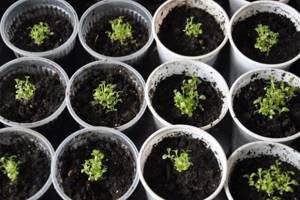
Bunched lobelia sprouts
The picked plants are shaded for 4-5 days while the temperature is lowered to +10...+15 °C. Then they are returned to the bright windowsill again.
Look how to pick lobelia, it's very simple:
10 days after diving, the seedlings are fed in the morning with a solution of ammonium nitrate (1/3 teaspoon per 1 liter of water). 100 ml of solution is used for 4-5 plants.
It is important to note that at this stage the plants need nitrogen to grow green mass.
When the seedlings grow to a height of 4-5 cm, they are pinched or trimmed with scissors to form a neat bush.
At the end of April, seedlings begin to harden in open air, leaving them first for 4-5 hours, and then for a whole day. In case of threat of frost, cover with non-woven material.
Transshipment of seedlings into open ground
May-June is the time to plant seedlings. You can determine the readiness of lobelia for transplantation by:
- the presence of full buds;
- some of the inflorescences are beginning to bloom.
Only the young plant is capricious and tender. With the appearance of buds with proper care. The flower becomes the owner of strong immunity. Shock after transfer from a container to open ground is well tolerated. The only point worth remembering is accuracy. Injuries to the root system lead to the death of all crops.
Seedlings should remain under cover at night for up to 5 days. In the morning, the polyethylene is removed so that the lobelia can fully enjoy the air and sunlight.
When to pick lobelia
Lobelia sprouts are tiny, so they sprout a month after the first shoots appear. The main identifying sign to start the process will be the appearance of two to three green leaves. Despite the fact that at this moment the size of the main plant is still very small, this is exactly the right time to replant the plant.
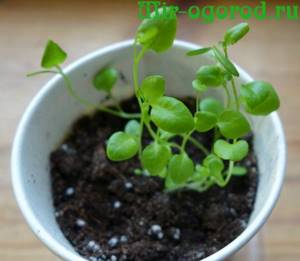
Specifics of plant care after transplantation
There is no difficulty in caring for lobelia. You can pre-determine events for a month or a week. The place for the flower should be warm, humid, but not excessively wet.
You will have to loosen the soil at least 2 times a week so that nitrogen and other minerals reach the roots.

Watering and fertilizing
The flower loves poor soils, but will not refuse feeding for flowering plants. You can buy such preparations at any gardening store. The number of applications should not exceed more than 3 times per season.
Watering is carried out 2 times a week with equal time intervals. In case of persistent heat, the amount is increased to 3. If there is frequent rain, then we reduce watering and remove excess water. Many gardeners specially make branches from the flower bed.
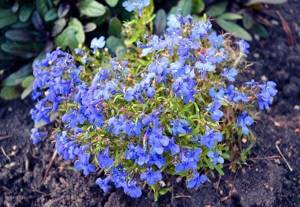
Weed removal
Timely loosening ensures not only loose soil around the plant, but also cleanliness. There should be no weeds around the lobelia. It takes away useful substances, which leads to deterioration of flowering.
Pruning lobelia for lush flowering
The secret to caring for lobelia is double pinching. The first is carried out after transplanting into separate containers so that the seedlings do not stretch. The second one is needed for tillering.
Carry out after the first flowering. Cut off the ground part so that a stump of at least 8 cm remains.
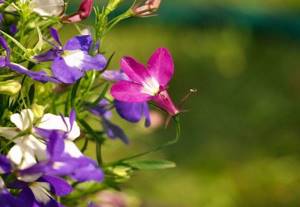
Watering lobelia
For harmonious growth of lobelia, it is enough to water it regularly and moderately and get rid of weeds. Drought has a detrimental effect on lobelia. During this period, you should water more often to keep the soil moist. Lack of moisture has a bad effect on flowering. And if the soil regularly dries out, the plant may die.
But lobelia does not tolerate stagnation of moisture in the root area, and exhibits all its decorative properties only with proper care.
After the first flowering, many gardeners trim the plant by 6-7 centimeters. After this, new shoots appear, and the lobelia blooms magnificently for the second time. To continue the flowering process at the end of summer, the soil around the plant is loosened and watered abundantly. Seed pods can be collected if propagation by self-sowing is not intended. Preparing for winter involves covering the lobelia with fallen leaves and trimming the stem.
Main problems and ways to solve them
Lobelia is considered a strong, disease-resistant flower. But incorrectly carried out procedures reduce the resistance of the culture. The most common problems when growing:
- Overwatering. Not all lobelias can grow in a humid environment. Watering should be done as needed (dry soil). Leads to the appearance of fungal diseases, blackleg. Solution: remove diseased shoots. Healthy ones should be disinfected together with the soil with biofungicides.
- Lobelias are often attacked by spider mites. Sucking insects try to get inside to absorb the juice. The green mass withers and withers. Solution to the problem: increase the number of waterings, regularly spray with a solution of soap shavings. In case of large damage, insecticides are used.
- The appearance of fungal diseases at the initial stage occurs due to the lack of tillage of the soil and container. In case of severe damage, all seed material will have to be replaced.
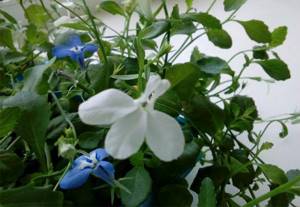
Picking lobelia step by step with photos and videos
How to properly pick lobelia seedlings:
- Fill the cups with soil and water it with Fitosporin solution.
You will be interested to know: Annual dahlias: planting and care, photos, when to plant seedlings
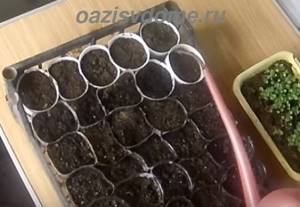
- We make depressions in the ground. The holes should be wide enough to accommodate several bushes at once.
- Using a fork or other tool, we dig up several seedlings at once along with a lump of earth.
- We place the bushes in the holes, sprinkle the roots with soil and carefully compact it.
- We water the seedlings a little so that the soil from the cup “grasps” the roots.
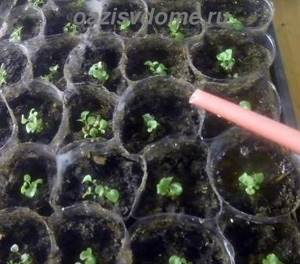
Some gardeners plant lobelia one bush at a time. But this requires a lot of containers and time. Digging and planting in groups is faster and easier, and the resulting bush will be thick and beautiful. Another reason for picking lobelia in groups is that the survival rate of one bush is not guaranteed, since the flower seedlings are very small. Some of the transplanted bundle will take root for sure.
Attention! If you grow lobelia in not very large pots in the summer, you can immediately transplant seedlings into them in a larger bunch.
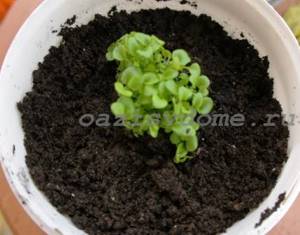
WATCH THE VIDEO OF PICKING LOBELIA SEEDLINGS INTO CUPS
How to get seeds after flowering
Lobelia seeds are collected in the standard way: after flowering, tie the bud with gauze. Do not wait until the inflorescence dries and withers. The grains are so small that the wind will quickly disperse them.
Provided that the lobelia bush has become especially beautiful throughout the season, you can omit the stage of collecting seed material. Moreover, the new plants will be 50% similar to the parent. Saving occurs according to the following principle:
- Carefully dig up the bush so as not to damage the roots;
- cut off faded buds;
- Wrap the roots and soil in a damp cloth. Wet regularly;
- send the workpiece to a cold place.
In spring, the harvest is divided into several bushes to be planted in separate pots. In May they are transplanted to a permanent place.

